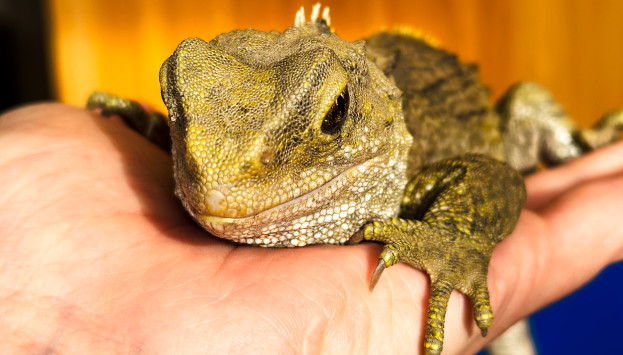Having seemingly dodged cancer, Merri the Tuatara is on a long road to recovery.
Still, at six years old and with a lifespan (disease and accidents notwithstanding) that can reach 200 years, time is on the side of this reptile.
A “happy accident” who was hatched at Queenstown’s Kiwi Park, Merri was recently admitted to the Dunedin Wildlife Hospital for investigation of a large mass under his jaw.
Merri is only the second tuatara to have been admitted to the Dunedin Wildlife Hospital since it opened at Otago Polytechnic | Te Pūkenga in early 2018.
Senior Wildlife Veterinarian Dr Lisa Argilla and Senior Wildlife Veterinary Nurse Angelina Martelli have a “fair amount of experience” with the species, but stress that they have been helped greatly by the expertise of others.
Merri’s medical condition was complicated as the mass was near many vital structures, including arteries, veins, thyroid glands, nerves, trachea and oesophagus. Therefore, a cautious approach needed to be taken to determine the nature of the mass.
“This has been a great collaborative effort with input and advice from a number of veterinarians, including Prof Brett Gartrell, a colleague at Wildbase at Massey University, who recommended an ultrasound for Merri.
“We then contacted the Green Island Veterinary Clinic’s Dr Scott Drummond, who facilitated an ultrasound at his clinic, as we don’t have one.”
Those ultrasound images helped Dr Argilla and company determine how best to proceed with surgery to remove a small part of the mass.
Still, surgery was extremely challenging – for a range of reasons.
Firstly, reptiles have very slow metabolisms (the metabolism of tuatara is even slower than other species). Also, reptiles have a reflex “death roll” response, not ideal when being operated on.
All of this meant it took around 45 minutes before Merri was in a deep enough “sleep” to be placed on his back and enable surgery to proceed.
“Even with ultrasound guidance on where to make the incision, surgery was tricky, and the mass bled a significant amount,” Dr Argilla explains. “Luckily, a piece of the mass was able to be removed and the bleeding able to be stopped – although it was touch and go for a while there.
“Merri recovered remarkably well from the surgery and you wouldn’t even know he’d had a near-death experience.”
And the results of all that painstaking exploratory work?
“The biopsy came back as a fungal infection. However, because of the size and location of the mass and the fact that it is growing about 1mm per week, the prognosis for recovery is still very guarded,” Dr Argilla says.
“It’s impossible, at this stage, to remove the mass without almost certainly killing Merri. So the plan for now is to medicate him with antifungal drugs and, hopefully, over time the mass will shrink to the point where it might be safe to surgically remove it.”
Slow metabolisms equal slow recovery times, too.
“We are looking at an extremely long treatment course for Merri – no less than six months but more likely much longer,” Dr Argilla says. “Our colleagues at Wildbase have had a Tuatara in care for 389 days before and this case could potentially break that record.”
Merri might not be out of the woods, so to speak, but he is at least enjoying some creature comforts.
Currently, Merri is residing in a “nice comfy enclosure” at the Wildlife Hospital, where he’s devouring yummy kai.
“A special shout-out to Otago Locusts,” Dr Argilla says. “They are providing the insects for free!”
Footnote: Based on size, Merri is assumed to be male, but no genetic testing has been done to confirm this.
Published on 31 Jul 2023
Orderdate: 31 Jul 2023
Expiry: 31 Jul 2025





